

INRA. MetaHIT. CBS. Danone Research. Research. EMBL Heidelberg. What's your gut type? - Press Release - Gut bacteria could help with diagnostics and influence treatments. Artistic impression of the 3 human gut types.
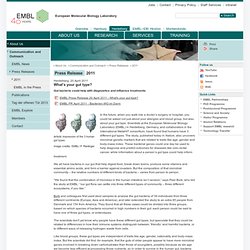
Image credits: EMBL/ P. Riedinger In the future, when you walk into a doctor’s surgery or hospital, you could be asked not just about your allergies and blood group, but also about your gut type. Scientists at the European Molecular Biology Laboratory (EMBL) in Heidelberg, Germany, and collaborators in the international MetaHIT consortium, have found that humans have 3 different gut types. The study, published today in Nature, also uncovers microbial genetic markers that are related to traits like age, gender and body-mass index. We all have bacteria in our gut that help digest food, break down toxins, produce some vitamins and essential amino acids, and form a barrier against invaders. Bacterial balance that keeps us healthy - Press Release - EMBL scientists present genetic catalogue of our gut flora.
The thousands of bacteria, fungi and other microbes that live in our gut are essential contributors to our good health.
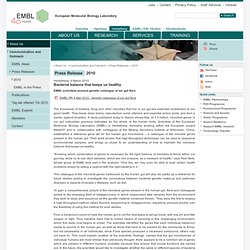
They break down toxins, manufacture some vitamins and essential amino acids, and form a barrier against invaders. A study published today in Nature shows that, at 3.3 million, microbial genes in our gut outnumber previous estimates for the whole of the human body. Scientists at the European Molecular Biology Laboratory (EMBL) in Heidelberg, Germany, working within the European project MetaHIT and in collaboration with colleagues at the Beijing Genomics Institute at Shenzhen, China, established a reference gene set for the human gut microbiome – a catalogue of the microbe genes present in the human gut.
Their work proves that high-throughput techniques can be used to sequence environmental samples, and brings us closer to an understanding of how to maintain the microbial balance that keeps us healthy. MetaHIT: Gut Instinct - EMBL in the Press. Vall d' Hebron Research Institute. Hagedorn Research Institute. UCB. Wageningen University. Humans shown to have intestinal bacteria groups as well as blood groups. Wellcome Trust Sanger Institute. MetaHIT Consortium. Background The Sanger Institute contributes to MetaHIT by producing draft nucleotide sequence for the genomes of 100 bacterial strains commonly found in the human intestinal tract.
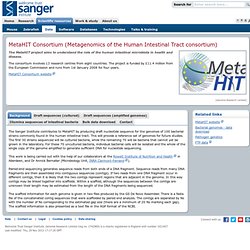
This will provide a reference set of genomes for future studies. The first 30 strains sequenced will be cultured bacteria, while the remaining 70 will be bacteria that cannot yet be grown in the laboratory. For these 70 uncultured bacteria, individual bacterial cells will be isolated and the whole of the single copy of the genome amplified to generate sufficient DNA for nucleotide sequencing.
This work is being carried out with the help of our collaborators at the Rowett Institute of Nutrition and Health in Aberdeen, and Dr Annick Bernalier (Microbiology Unit, INRA Clermont-Ferrand Paired-end sequencing generates sequence reads from both ends of a DNA fragment. The scaffold information for each genome is given in two files produced by the GS De Novo Assembler. Draft Genome Sequences for Cultured Strains.
CEA Genoscope. Projects4. Metagenomics of Human Intestinal Tract (MetaHIT) Collaboratiion with 7 countries and 11 institutes from Europe Metagenomics is the study of microbial genetic material recovered directly from environmental samples, such as human intestinal, soil, liquor-making koji and etc.
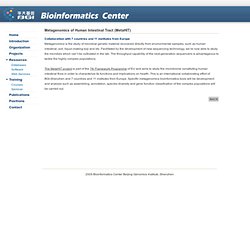
Facilitated by the development of new sequencing technology, we’re now able to study the microbes which can’t be cultivated in the lab. The throughput capability of the next-generation sequencers is advantageous to tackle the highly complex populations. University of Copenhagen. What's your intestinal bacteria type? 20 April 2011 Interstinal flora types As partners in the international research consortium named MetaHit, scientists from the University of Copenhagen have contributed to show that an individual’s intestinal bacteria flora, regardless of nationality, gender and age, organises itself in certain clusters.
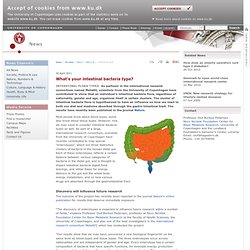
The cluster of intestinal bacteria flora is hypothesised to have an influence on how we react to both our diet and medicine absorbed through the gastro-intestinal tract. The results have recently been published in the journal Nature. Most people know about blood types, some also know about tissue types. Discovery will influence future research The outcome of the project has recently been reported in the journal Nature’s online publication for results that deserve immediate exposure. ”Our results show that we may have uncovered a new ‘biological fingerprint’ on the same level as blood types and tissue types. New opportunity for studying gut bacteria Contact. Merieux Institute. Merieux Institute - Food safety : public health projects. Institut Mérieux: committed to nutrition and health Preventing infectious or toxicological risks linked to food, providing a high level of safety and quality for these products, contributing to the development of functional foods with health benefits, form one of the priorities of Institut Mérieux.
Mérieux NutriSciences (with its three divisions) and bioMérieux, in particular with its industrial microbiology activities, are the Group’s backbone in this area. Both are world leaders. Mérieux NutriSciences provides services to agri-food and food service companies, and distributors: biological and chemical analyses, R&D, clinical studies, auditing and consulting, training. bioMérieux develops, produces and distributes systems and reagents for diagnosis used by monitoring laboratories for microbiological quality control in agri-food, pharmaceutical and cosmetics industries. Through these two companies, Institut Mérieux thus provides overlapping expertise to its partners.